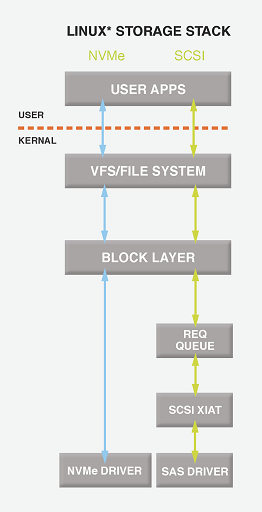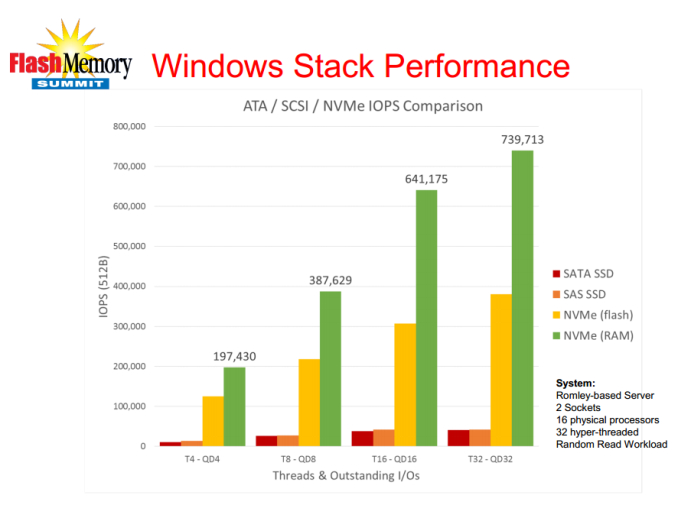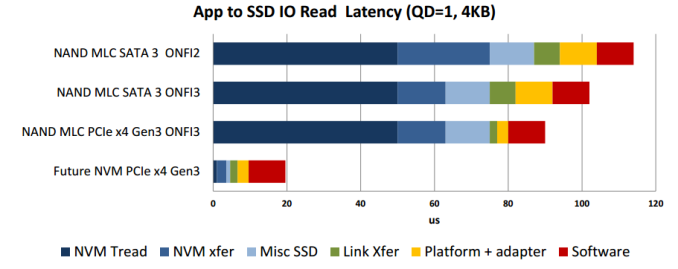Testing SATA Express And Why We Need Faster SSDs
by Kristian Vättö on March 13, 2014 7:00 AM EST- Posted in
- Storage
- SSDs
- Asus
- SATA
- SATA Express
NVMe vs AHCI: Another Win for PCIe
Improving performance is never just about hardware. Faster hardware can only help to reach the limits of software and ultimately more efficient software is needed to take full advantage of the faster hardware. This applies to SSDs as well. With PCIe the potential bandwidth increases dramatically and to take full advantage of the faster physical interface, we need a software interface that is optimized specifically for SSDs and PCIe.
AHCI (Advanced Host Controller Interface) dates back to 2004 and was designed with hard drives in mind. While that doesn't rule out SSDs, AHCI is more optimized for high latency rotating media than low latency non-volatile storage. As a result AHCI can't take full advantage of SSDs and since the future is in non-volatile storage (like NAND and MRAM), the industry had to develop a software interface that abolishes the limits of AHCI.
The result is NVMe, short for Non-Volatile Memory Express. It was developed by an industry consortium with over 80 members and the development was directed by giants like Intel, Samsung, and LSI. NVMe is built specifically for SSDs and PCIe and as software interfaces usually live for at least a decade before being replaced, NVMe was designed to be capable of meeting the industry needs as we move to future memory technologies (i.e. we'll likely see RRAM and MRAM enter the storage market before 2020).
| NVMe | AHCI | |
| Latency | 2.8 µs | 6.0 µs |
| Maximum Queue Depth |
Up to 64K queues with 64K commands each |
Up to 1 queue with 32 commands each |
| Multicore Support | Yes | Limited |
| 4KB Efficiency | One 64B fetch |
Two serialized host DRAM fetches required |
Source: Intel
The biggest advantage of NVMe is its lower latency. This is mostly due to a streamlined storage stack and the fact that NVMe requires no register reads to issue a command. AHCI requires four uncachable register reads per command, which results in ~2.5µs of additional latency.
Another important improvement is support for multiple queues and higher queue depths. Multiple queues ensure that the CPU can be used to its full potential and that the IOPS is not bottlenecked by single core limitation.
Source: Microsoft
Obviously enterprise is the biggest beneficiary of NVMe because the workloads are so much heavier and SATA/AHCI can't provide the necessary performance. Nevertheless, the client market does benefit from NVMe but just not as much. As I explained in the previous page, even moderate improvements in performance result in increased battery life and that's what NVMe will offer. Thanks to lower latency the disk usage time will decrease, which results in more time spend at idle and thus increased battery life. There can also be corner cases when the better queue support helps with performance.
Source: Intel
With future non-volatile memory technologies and NVMe the overall latency can be cut to one fifth of the current ~100µs latency and that's an improvement that will be noticeable in everyday client usage too. Currently I don't think any of the client PCIe SSDs support NVMe (enterprise has been faster at adopting NVMe) but the SF-3700 will once it's released later this year. Driver support for both Windows and Linux exists already, so it's now up to SSD OEMs to release compatible SSDs.













131 Comments
View All Comments
frenchy_2001 - Friday, March 14, 2014 - link
no, it does not. It adds latency, which is the delay before any command is received. Speed stays the same and unless your transmission depends on hand shake and verification and can block, latency is irrelevant.See internet as a great example. Satellite gives you fast bandwidth (it can send a lot of data at a time), but awful latency (it takes seconds to send the data).
As one point of those new technology is to add a lot of queuing, latency becomes irrelevant, as there is always some data to send...
nutjob2 - Saturday, March 15, 2014 - link
You're entirely incorrect. Speed is a combination of both latency and bandwidth and both are important, depending on how the data is being used.Your dismissal of latency because "there is always data to send" is delusional. That's just saying that if you're maxing out the bandwidth of your link then latency doesn't matter. Obviously. But in the real world disk requests are small and intermittent and not large enough to fill the link, unless you're running something like a database server doing batch processing. As the link speed gets faster (exactly what we're talking about here) and typical data request sizes stay roughly the same then latency becomes a larger part of the time it takes to process a request.
Perceived and actual performance on most computers are very sensitive to disk latency since the disk link is the slowest link in the processing chain.
MrPoletski - Thursday, March 13, 2014 - link
wait:by Kristian Vättö on March 13, 2014 7:00 AM EST
It's currently March 13, 2014 6:38 AM EST - You got a time machine over at Anandtech?
Ian Cutress - Thursday, March 13, 2014 - link
I think the webpage is in EDT now, but still says EST.Bobs_Your_Uncle - Saturday, March 15, 2014 - link
PRECISELY the point of Kristian's post. It's NOT a time machine in play, but rather the dramatic effects of reduced latency. (The other thing that happens is the battery in your laptop actually GAINS charge in such instances.)mwarner1 - Thursday, March 13, 2014 - link
The cable design, and especially its lack of power transmission, is even more short sighted & hideous than that of the Micro-B USB3.0 cable.3DoubleD - Thursday, March 13, 2014 - link
Agreed, what a terrible design. Not only is this cable a monster, but I can already foresee the slow and painful rollout of PCIe2.0 SATAe when we should be skipping directly to PCIe3.0 at this point.Also, the reasons given for needing faster SATA SSDs are sorely lacking. Why do we need this hideous connector when we already have PCIe SSDs? Plenty of laptop vendors are having no issue with this SATA bottleneck. I also debate whether a faster, more power hungry interface is actually better on battery life. The SSD doesn't always run at full speed when being accessed, so the battery life saved will be less than the 10 min calculated in the example... if not worse that the reference SATA3 case! And the very small number of people who edit 4k videos can get PCIe SSDs already.
DanNeely - Thursday, March 13, 2014 - link
Blame Intel and AMD for only putting pcie 2.0 on the southbridge chips that everything not called a GPU are connected to in consumer/enthusiast systems.Kristian Vättö - Thursday, March 13, 2014 - link
A faster SSD does not mean higher power consumption. The current designs could easily go above 550MB/s if SATA 6Gbps wasn't bottlenecking, so a higher power controller is not necessary in order to increase performance.fokka - Thursday, March 13, 2014 - link
i think what he meant is that while the actual workload may be processed faster and an idle state is reached sooner on a faster interface, the faster interface itself uses more power than sata 6g. so the question now is in what region the savings of the faster ssd are and in what region the additional power consumption of the faster interface.